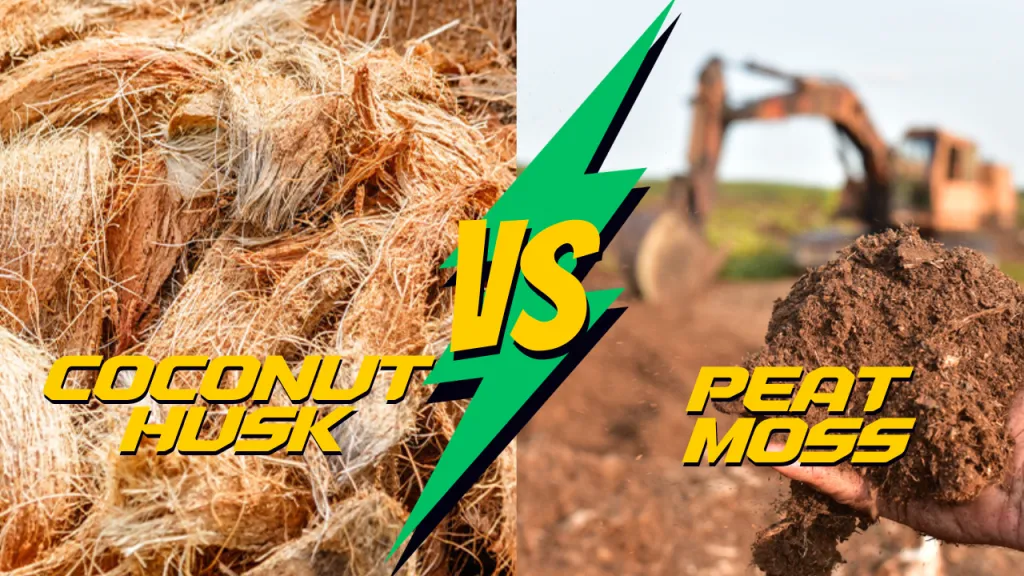Understanding Coconut Husk (Coir): Benefits and Uses
Both coconut husk (often referred to as coir) and peat moss are popular choices as soil amendments in gardening. They can improve soil texture, water retention, and aeration. However, there are distinct differences between the two, including their origins, properties, and environmental impacts. Let’s delve into a detailed comparison.
1. Origin and Composition
Coconut Husk (Coir):
- Derived from the fibrous husk of coconuts.
- It’s a renewable resource, as coconuts are harvested every year.
Peat Moss:
- Comprises partially decayed organic matter accumulated over thousands of years in peat bogs.
- Extracted from wetland areas, making it a non-renewable resource.
2. pH Level
Coconut Husk (Coir):
- Typically has a near-neutral pH level, which is favorable for most plants.
Peat Moss:
- Tends to be acidic, with a pH of 3.5 to 6.0. This makes it suitable for acid-loving plants but may require lime to balance the pH for other plants.
3. Water Retention and Drainage
Coconut Husk (Coir):
- Excellent water retention capabilities, often holding up to 10 times its weight in water.
- Provides good aeration, ensuring roots receive adequate oxygen.
Peat Moss:
- Also has high water retention but can sometimes become too waterlogged.
- Can become compacted over time, potentially reducing aeration.
4. Sustainability and Environmental Impact
Coconut Husk (Coir):
- Considered sustainable as it’s a byproduct of the coconut industry.
- Harvesting doesn’t harm the environment.
Peat Moss:
- Harvesting from peat bogs can damage ecosystems, release stored carbon, and contribute to greenhouse gas emissions.
- Takes several millennia to form, making it less sustainable.
5. Nutrient Content
Coconut Husk (Coir):
- Generally, coir is low in nutrients. However, it can hold onto nutrients applied via fertilizers, making them available to plants.
Peat Moss:
- Also low in nutrients and may require additional fertilization for optimal plant growth.
6. Lifespan and Degradability
Coconut Husk (Coir):
- Decomposes at a slower rate compared to many organic materials, providing a longer-lasting growing medium.
Peat Moss:
- Decomposes slowly due to its anaerobic origin. This can be both an advantage (longevity in the soil) and a disadvantage (less frequent aeration).
My Journey from Peat Moss to Coconut Husk: A Gardener’s Tale
When I first decided to set up my garden, I was a novice. The thrill of cultivating plants from seedlings, watching them grow into full-fledged flora, was a dream I was eager to realize. As any budding gardener would do, I began researching the best soil amendments to give my plants the best start.
One name kept cropping up: peat moss. Many articles praised its water retention capabilities and its acidic nature. It seemed like the golden standard for soil enrichment. Without hesitation, I decided to incorporate peat moss into my garden beds.
Initially, the results were impressive. My azaleas and rhododendrons, which thrive in acidic soil, blossomed with vigor. But as I delved deeper into my gardening hobby, attending workshops and joining online communities, I began to hear murmurs of the environmental impact of peat moss. Its harvesting, I learned, wasn’t just a simple collection process. It involved extracting layers of ancient wetland ecosystems, releasing significant amounts of stored carbon, and contributing to greenhouse gas emissions. This revelation was unsettling.
My excitement waned slightly, but my journey was far from over. In one of my community garden meetings, a fellow enthusiast introduced me to the wonders of coconut husk, commonly known as coir. She shared its sustainable origin, stemming from the abundant coconut industry, and its impressive water retention capabilities without becoming too waterlogged.
Intrigued, I decided to give coconut husk a shot. Transitioning my garden beds from peat moss to coir was a process. But as weeks turned into months, I noticed my plants were thriving just as much, if not more. The coir provided excellent aeration, ensuring the roots of my plants received the oxygen they craved. Plus, its near-neutral pH made it versatile for a variety of plants, not just the acid-lovers.
One particular moment stands out during this transition. After a heavy downpour, I inspected my garden. The beds with coir retained moisture without becoming a soggy mess, while some of my remaining peat moss sections were waterlogged, much to my dismay.
Today, as I sip my morning tea, gazing out at the lush green canvas of my garden, I feel a sense of pride. Not just for the vibrant flora that greets me but for the choices I’ve made. Choices that prioritize the health of my plants and the well-being of our planet.
Gardening, I’ve realized, isn’t just about nurturing plants; it’s about cultivating awareness and making decisions that echo our responsibility to nature. And as I’ve learned, sometimes, the best choices are those that honor both our gardens and the earth.
Conclusion
Both coconut husk (coir) and peat moss offer unique benefits to gardeners. While coir is praised for its sustainability and near-neutral pH, peat moss is often favored by those growing acid-loving plants. Your choice will depend on your specific gardening needs, environmental considerations, and the plants you’re cultivating. Before making a decision, always consider the ecological footprint and the long-term health of your garden.

